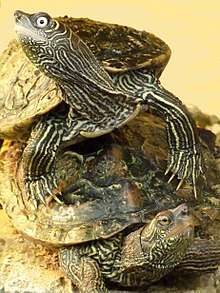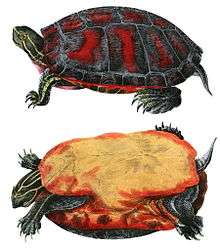Mississippi map turtle
| Graptemys pseudogeographica kohni | |
|---|---|
 | |
| Top: Mississippi Map Turtle; Bottom: False Map Turtle | |
| Scientific classification | |
| Kingdom: | Animalia |
| Phylum: | Chordata |
| Class: | Reptilia |
| Order: | Testudines |
| Suborder: | Cryptodira |
| Family: | Emydidae |
| Genus: | Graptemys |
| Species: | G. pseudogeographica |
| Subspecies: | G. p. kohni |
| Trinomial name | |
| Graptemys pseudogeographica kohni (Baur, 1890) | |
| Synonyms | |
| |
The Mississippi map turtle (Graptemys pseudogeographica kohni) is a subspecies of land & water turtle belonging to the family Emydidae. G. p. kohni is endemic to the central United States. Map turtles get their common name from the lines and markings on their carapace which resemble the contour lines of a map. They occur in the Mississippi Valley from Illinois and Nebraska, down into the Gulf States from Mississippi to Texas, usually in rivers, lakes and large streams (not typically in isolated farm ponds or small creeks). They tend to prefer habitat with abundant vegetation.
Etymology
The Mississippi map turtle derives its common name not from the state of Mississippi, but rather from the Mississippi River.
The specific name, kohni, is in honor of amateur naturalist Joseph Gustave Kohn (1837-1906) of New Orleans, Louisiana, who collected the type specimen.[3][4]
Geographic range
It is found along the Mississippi River and its tributaries, from Illinois and Missouri southward. Also one reported to be found in South Lyon, MI[5]
Description
Females are considerably larger than males, the adult male being 3.5 to 5 inches (about 9 to 13 cm) in carapace length, and the adult female from 6 to 10 inches (about 15 to 25 cm) in carapace length. Males have a leaner look, more like juveniles, but females have a larger, bulkier build.
Captivity
It is a popular pet for aquarists and is very enjoyable to watch.
References
- ↑ Fritz, Uwe; Peter Havaš (2007). "Checklist of Chelonians of the World" (PDF). Vertebrate Zoology. 57 (2): 189. Archived from the original (PDF) on 17 December 2010. Retrieved 29 May 2012.
- ↑ The Reptile Database. www.reptile-database.org.
- ↑ Baur, G. (1890). Two New Species of Tortoises from the South. Science 16 (405): 262-263.
- ↑ Beolens, Bo; Michael Watkins; Michael Grayson. (2007). The Eponym Dictionary of Reptiles. Johns Hopkins University Press. Baltimore. xiii + 296 pp. ISBN 978-1-4214-0135-5. (Graptemys kohni, p. 145.)
- ↑ http://www.austinsturtlepage.com/Care/caresheet-mississippi_map.htm
Further reading
- Conant, R. (1975). A Field Guide to Reptiles and Amphibians of Eastern and Central North America, Second Edition. Houghton Mifflin. Boston. xviii + 429 pp. + 48 plates. ISBN 0-395-19979-4 (hardback), ISBN 0-395-19977-8 (paperback). (Graptemys kohni pp. 56–57 + Plates 5, 8 + Map 19.)
- Smith, H.M., and E.D. Brodie, Jr. (1982). Reptiles of North America: A Guide to Field Identification. Golden Press. New York. 240 pp. ISBN 0-307-13666-3 (paperback). (Graptemys pseudogeographica kohni, pp. 50–51.)

